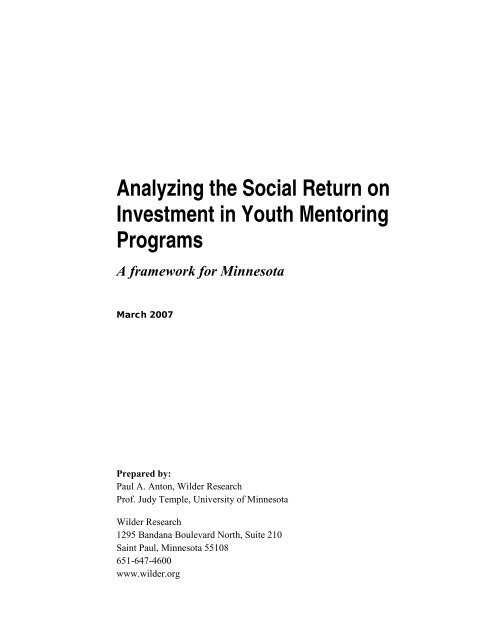Analyzing the Social Return on Investment in Youth Mentoring ...
Analyzing the Social Return on Investment in Youth Mentoring ...
Analyzing the Social Return on Investment in Youth Mentoring ...
You also want an ePaper? Increase the reach of your titles
YUMPU automatically turns print PDFs into web optimized ePapers that Google loves.
<str<strong>on</strong>g>Analyz<strong>in</strong>g</str<strong>on</strong>g> <str<strong>on</strong>g>the</str<strong>on</strong>g> <str<strong>on</strong>g>Social</str<strong>on</strong>g> <str<strong>on</strong>g>Return</str<strong>on</strong>g> <strong>on</strong><strong>Investment</strong> <strong>in</strong> <strong>Youth</strong> Mentor<strong>in</strong>gProgramsA framework for M<strong>in</strong>nesotaMarch 2007Prepared by:Paul A. Ant<strong>on</strong>, Wilder ResearchProf. Judy Temple, University of M<strong>in</strong>nesotaWilder Research1295 Bandana Boulevard North, Suite 210Sa<strong>in</strong>t Paul, M<strong>in</strong>nesota 55108651-647-4600www.wilder.org
AcknowledgmentsThis study was commissi<strong>on</strong>ed by <str<strong>on</strong>g>the</str<strong>on</strong>g> Mentor<strong>in</strong>gPartnership of M<strong>in</strong>nesota.The study received fund<strong>in</strong>g from <str<strong>on</strong>g>the</str<strong>on</strong>g> follow<strong>in</strong>g organizati<strong>on</strong>s:The Mentor<strong>in</strong>g Partnership of M<strong>in</strong>nesota, Center for 4-H &Community <strong>Youth</strong> Development of <str<strong>on</strong>g>the</str<strong>on</strong>g> University ofM<strong>in</strong>nesota Extensi<strong>on</strong>, The Curtis L. Carls<strong>on</strong> FamilyFoundati<strong>on</strong>, and IWCO Direct.This study was d<strong>on</strong>e at <str<strong>on</strong>g>the</str<strong>on</strong>g> same time as a compani<strong>on</strong> study of youth <strong>in</strong>terventi<strong>on</strong>programs. The studies share a comm<strong>on</strong> methodological framework.Pr<strong>in</strong>cipal thanks must go to Joellen G<strong>on</strong>der-Spacek, Executive Director of <str<strong>on</strong>g>the</str<strong>on</strong>g> Mentor<strong>in</strong>gPartnership of M<strong>in</strong>nesota for her role <strong>in</strong> envisi<strong>on</strong><strong>in</strong>g this research and <strong>in</strong> mak<strong>in</strong>g it areality. Polly Roach, Vice-President of Strategic Services provided <strong>in</strong>valuable help <strong>in</strong>describ<strong>in</strong>g <strong>in</strong>dividual programs and putt<strong>in</strong>g us <strong>in</strong> touch with program leaders for<strong>in</strong>terviews.We also wish to thank Dale A. Blyth, Associate Dean of <str<strong>on</strong>g>the</str<strong>on</strong>g> Extensi<strong>on</strong> Divisi<strong>on</strong> of <str<strong>on</strong>g>the</str<strong>on</strong>g>University of M<strong>in</strong>nesota for his role <strong>in</strong> promot<strong>in</strong>g and shap<strong>in</strong>g <str<strong>on</strong>g>the</str<strong>on</strong>g> research agenda thateventually led to this study and its compani<strong>on</strong>.F<strong>in</strong>ally, thanks go to Brent J. Bolstrom, <str<strong>on</strong>g>the</str<strong>on</strong>g>n a graduate research assistant at <str<strong>on</strong>g>the</str<strong>on</strong>g> Centerfor 4-H & Community <strong>Youth</strong> Development of <str<strong>on</strong>g>the</str<strong>on</strong>g> University of M<strong>in</strong>nesota Extensi<strong>on</strong>,both for his survey work <strong>on</strong> social return <strong>on</strong> <strong>in</strong>vestment quoted <strong>in</strong> this study and forsupply<strong>in</strong>g us with a database <strong>on</strong> youth programs that he had compiled.*Copies of this report are brought to you by <str<strong>on</strong>g>the</str<strong>on</strong>g> Center for 4-H & Community <strong>Youth</strong>Development’s Applied Research Collaborative <strong>on</strong> <strong>Youth</strong> Development of <str<strong>on</strong>g>the</str<strong>on</strong>g> Universityof M<strong>in</strong>nesota Extensi<strong>on</strong>. The Applied Research Collaborative is a network of researchers,evaluators and youth professi<strong>on</strong>als dedicated to stimulat<strong>in</strong>g, guid<strong>in</strong>g and c<strong>on</strong>duct<strong>in</strong>gapplied research and bridg<strong>in</strong>g research with practice, program and policy.This Study Proudly Sp<strong>on</strong>sored By:SROI of <strong>Youth</strong> Mentor<strong>in</strong>g Programs Wilder Research, March 2007
Executive summary<strong>Youth</strong> mentor<strong>in</strong>g programs perform an <strong>in</strong>creas<strong>in</strong>gly vital functi<strong>on</strong> by br<strong>in</strong>g<strong>in</strong>g childrenand youth <strong>in</strong>to c<strong>on</strong>tact with committed, car<strong>in</strong>g adults <strong>in</strong> order to build attitudes and skillswhich will help <str<strong>on</strong>g>the</str<strong>on</strong>g>m be productive and fulfilled citizens. This study puts forward aframework for quantify<strong>in</strong>g <str<strong>on</strong>g>the</str<strong>on</strong>g> value of <str<strong>on</strong>g>the</str<strong>on</strong>g> benefits of youth mentor<strong>in</strong>g programs andcompar<strong>in</strong>g <str<strong>on</strong>g>the</str<strong>on</strong>g>m to program costs <strong>in</strong> order to calculate <str<strong>on</strong>g>the</str<strong>on</strong>g> social return-<strong>on</strong>-<strong>in</strong>vestment(SROI) of such programs.Major f<strong>in</strong>d<strong>in</strong>gs• Many organizati<strong>on</strong>s <strong>in</strong> M<strong>in</strong>nesota offer a spectrum of youth mentor<strong>in</strong>g services, both <strong>in</strong><str<strong>on</strong>g>the</str<strong>on</strong>g> Tw<strong>in</strong> Cities Metropolitan area and <strong>in</strong> Greater M<strong>in</strong>nesota.• While <str<strong>on</strong>g>the</str<strong>on</strong>g>re may be broad, and perhaps <strong>in</strong>creas<strong>in</strong>g, recogniti<strong>on</strong> of <str<strong>on</strong>g>the</str<strong>on</strong>g> value of youthmentor<strong>in</strong>g programs, <str<strong>on</strong>g>the</str<strong>on</strong>g>re have been <strong>on</strong>ly limited attempts to analyze that value <strong>in</strong>ec<strong>on</strong>omic terms.• Based <strong>on</strong> our study of mentor<strong>in</strong>g programs <strong>in</strong> M<strong>in</strong>nesota, it is clear that such programscan produce some or all of <str<strong>on</strong>g>the</str<strong>on</strong>g> follow<strong>in</strong>g direct benefits whose values can (<strong>in</strong> pr<strong>in</strong>ciple)be quantified:• Improved school attendance and performance – lead<strong>in</strong>g to <strong>in</strong>creased graduati<strong>on</strong>rates, <strong>in</strong>creased post-sec<strong>on</strong>dary educati<strong>on</strong>, and higher lifetime earn<strong>in</strong>gs;• Reduced truancy – result<strong>in</strong>g <strong>in</strong> reduced school costs and, ultimately, reducedhigh school dropouts and <strong>in</strong>creased lifetime earn<strong>in</strong>gs;• Improved health outcomes – <strong>in</strong>clud<strong>in</strong>g reducti<strong>on</strong>s <strong>in</strong> teen pregnancy, reduced ordelayed use of tobacco, alcohol, or illicit drugs;• Reduced juvenile crime (both violence and property crimes) – sav<strong>in</strong>g victimcosts, court costs, and costly treatment of juvenile offenders;• Reduced costs of adult crime – both <str<strong>on</strong>g>the</str<strong>on</strong>g> crime losses of victims and <str<strong>on</strong>g>the</str<strong>on</strong>g> societalcosts of prosecut<strong>in</strong>g and <strong>in</strong>carcerat<strong>in</strong>g adult offenders;• Reduced needs for social services – both near-term costs of counsel<strong>in</strong>g andl<strong>on</strong>g-term costs of public assistance;SROI of <strong>Youth</strong> Mentor<strong>in</strong>g Programs 1 Wilder Research, March, 2007
• This paper expla<strong>in</strong>s a framework for compar<strong>in</strong>g <str<strong>on</strong>g>the</str<strong>on</strong>g> dollar value of costs and benefitsof youth mentor<strong>in</strong>g programs <strong>in</strong> M<strong>in</strong>nesota. This framework can be used to calculate<str<strong>on</strong>g>the</str<strong>on</strong>g> social return-<strong>on</strong>-<strong>in</strong>vestment (SROI) of such programs.• The formal applicati<strong>on</strong> of this framework to estimate <str<strong>on</strong>g>the</str<strong>on</strong>g> SROI of a particularprogram would require ei<str<strong>on</strong>g>the</str<strong>on</strong>g>r data from a complete, scientific program evaluati<strong>on</strong> that<strong>in</strong>cluded an unmentored c<strong>on</strong>trol group or, at a m<strong>in</strong>imum, detailed c<strong>on</strong>temporaneousand follow-up data <strong>on</strong> program participants that could be compared to norms foryouth of similar age and background.• The applied practice of valu<strong>in</strong>g <str<strong>on</strong>g>the</str<strong>on</strong>g> benefits of youth programs (when sufficientoutcomes data is available) is a rapidly evolv<strong>in</strong>g field of <strong>in</strong>quiry. More and more of<str<strong>on</strong>g>the</str<strong>on</strong>g>se potential benefits can be <strong>in</strong>cluded <strong>in</strong> analyses as SROI analysis becomes morewidespread and as necessary data becomes available.• Based <strong>on</strong> very limited outcomes data available for M<strong>in</strong>nesota youth programs, <str<strong>on</strong>g>the</str<strong>on</strong>g>results of a few nati<strong>on</strong>al program evaluati<strong>on</strong>s, and c<strong>on</strong>servative assumpti<strong>on</strong>s <strong>in</strong> l<strong>in</strong>ewith <str<strong>on</strong>g>the</str<strong>on</strong>g> experience of M<strong>in</strong>nesota youth programs, we provide an SROI analysis of aficti<strong>on</strong>al composite representative mentor<strong>in</strong>g program. We estimate that:• Based <strong>on</strong> c<strong>on</strong>servative assumpti<strong>on</strong>s about outcomes and valuati<strong>on</strong>s, ourrepresentative program returns benefits of $2.72 for every dollar ofresources used.• The program returns $2.08 for every dollar of cost if <str<strong>on</strong>g>the</str<strong>on</strong>g> value of mentors’time is excluded from <str<strong>on</strong>g>the</str<strong>on</strong>g> estimated benefits.• The program returns $1.87 of public benefits (public cost sav<strong>in</strong>gs and<strong>in</strong>creased tax revenues) for every dollar actually spent <strong>on</strong> <str<strong>on</strong>g>the</str<strong>on</strong>g> program.• The actual returns for a particular program would depend <strong>on</strong> <str<strong>on</strong>g>the</str<strong>on</strong>g> outcomes andexpenses of that particular program. We believe that returns <strong>in</strong> <str<strong>on</strong>g>the</str<strong>on</strong>g> example presentedhere fairly represent <str<strong>on</strong>g>the</str<strong>on</strong>g> returns that are achievable for well-run, effective mentor<strong>in</strong>gprograms. In some cases, it is certa<strong>in</strong>ly possible that returns could be higher than<str<strong>on</strong>g>the</str<strong>on</strong>g>se examples, especially when a program deals with very high-risk populati<strong>on</strong>s.• To produce more accurate and detailed analyses of <strong>in</strong>dividual programs, moredetailed data <strong>on</strong> program participants will need to be kept <strong>in</strong> order to measure anddocument juvenile and adult outcomes more precisely. This data collecti<strong>on</strong> could<strong>in</strong>clude an <strong>in</strong>termediate-term (5- to 10-year) l<strong>on</strong>gitud<strong>in</strong>al study of participants andsimilar youth who do not participate <strong>in</strong> mentor<strong>in</strong>g programs.SROI of <strong>Youth</strong> Mentor<strong>in</strong>g Programs 2 Wilder Research, March, 2007



